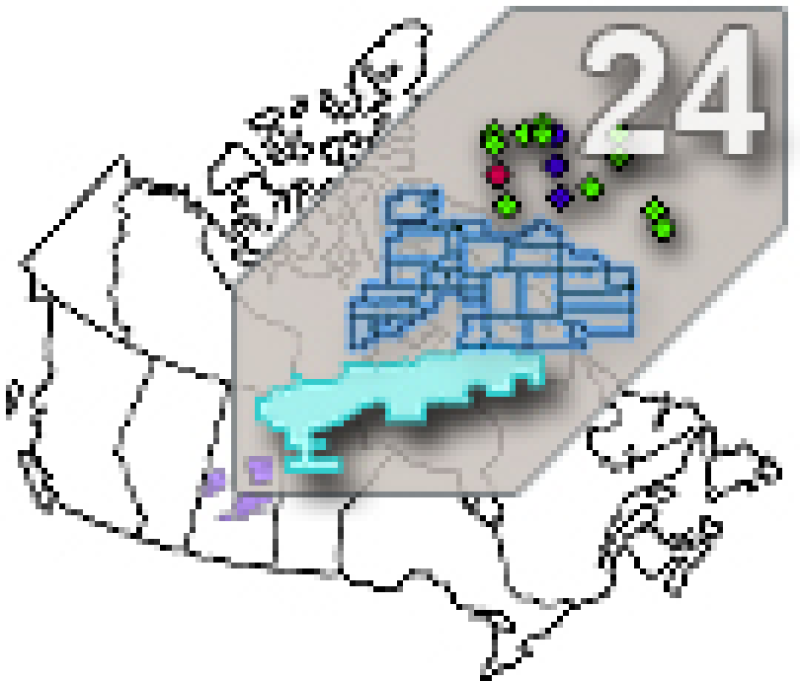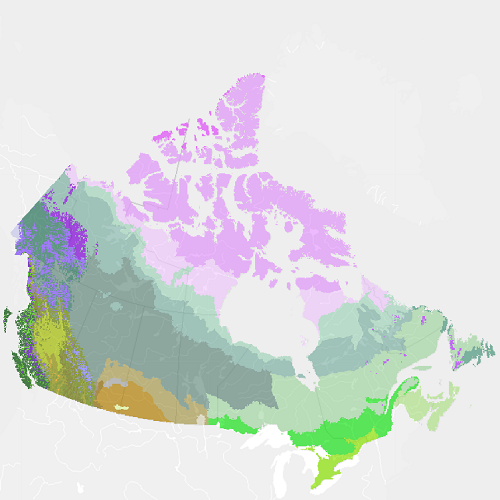Grasslands
Type of resources
Available actions
Topics
Keywords
Contact for the resource
Provided by
Years
Formats
Representation types
Update frequencies
status
Service types
-

The Community Pasture Program was a land-management service provided in the Prairie provinces. The program ended on March 31, 2019. The geographic data series that was associated with the program included information about program geography and facilities, including representations of fences and the fields they enclose, pasture outlines and features such as corrals, dams and gates. The information provided in this series is for reference purposes only.
-

Historical Open Range - 1963-1994 is a polygon layer that depicts grasslands and shrublands (originally designated as 'on land deemed with no potential for growing trees'). Data were derived from a (retired) Provincial Forest Cover Polygon dataset which was interpreted from air photos. Photograph and interpretation dates range from 1963 to 1994. This dataset has value as temporal snapshots of ecosystems under siege from human and natural processes. Data is useful for identification and analysis of forest ingrowth into grasslands from fire suppression. Encroachment can shift over time, for example from changing climate and disturbance events, and this data provides one measure of that shift. Data may also inform location of wildfire safety buffers around communities.
-

The “Agricultural Land Practices Groups of the Canadian Prairies” dataset lays out the areas of the 13 Land Practices Groups of the agricultural portions of the Canadian Prairies. They are represented by vector polygons amalgamated (dissolved) from the Version 1.9 SLC polygons sharing common water resources, land use and farming practices as developed in the “Agricultural Land Practices Groups of the Canadian Prairies by SLC Polygon” of this series. The dataset is based upon selected attributes from the Soil Landscapes of Canada (SLC) and the 1996 Census of Agriculture. Typical attributes including: land in pasture, land in summerfallow, crop mixture, farm size and the level of chemical and fertilizer inputs.
-
The "Prairie Agricultural Landscapes (PAL)" datasets identify areas of the agricultural portions of the Canadian Prairies with similar land and water resources, land use and farming practices. They are represented by vector polygons. Based on selected attributes from the Soil Landscapes of Canada (SLC) and the 1996 Census of Agriculture, the Prairies were classified into 13 (thirteen) classes of Land Practices Group and five (5) Major Land Practices Groups. Typical attributes used to define the Land Practice Groups include: land in pasture, land in summerfallow, crop mixture, farm size and the level of chemical and fertilizer inputs. The five (5) Major Groups were devised to help better understand the relationships between the groups. For more information, visit: https://open.canada.ca/data/en/dataset/0b2303be-ef05-49a8-8082-44a3eabcfa57
-
The "Prairie Agricultural Landscapes (PAL)" datasets identify areas of the agricultural portions of the Canadian Prairies with similar land and water resources, land use and farming practices. They are represented by vector polygons. Based on selected attributes from the Soil Landscapes of Canada (SLC) and the 1996 Census of Agriculture, the Prairies were classified into 13 (thirteen) classes of Land Practices Group and five (5) Major Land Practices Groups. Typical attributes used to define the Land Practice Groups include: land in pasture, land in summerfallow, crop mixture, farm size and the level of chemical and fertilizer inputs. The five (5) Major Groups were devised to help better understand the relationships between the groups. For more information, visit: https://open.canada.ca/data/en/dataset/0b2303be-ef05-49a8-8082-44a3eabcfa57
-

"Vegetation Zones of Canada: a Biogeoclimatic Perspective" maps Canadian geography in relation to gradients of regional climate, as expressed by potential vegetation on zonal sites. Compared to previous similar national-scale products, "Vegetation Zones of Canada" benefits from the work of provincial and territorial ecological classification programs over the last 30+ years, incorporating this regional knowledge of ecologically significant climatic gradients into a harmonized national map. This new map, reflecting vegetation and soils adapted to climates prior to approximately 1960, can serve as a broad-scale (approximately 1:5 M to 1:10 M) geospatial reference for monitoring and modeling effects of climate changes on Canadian ecosystems. "Vegetation Zones of Canada: a Biogeoclimatic Perspective" employs a two-level hierarchical legend. Level 1 vegetation zones reflect the global-scale latitudinal gradient of annual net radiation, as well as the effects of high elevation and west to east climatic and biogeographic variation across Canada. Within the level 1 vegetation zones, level 2 zones distinguish finer scale variation in zonal vegetation, especially in response to elevational and arctic climatic gradients, climate-related floristics and physiognomic diversity in the Great Plains, and maritime climatic influences on the east and west coasts. Thirty-three level 2 vegetation zones are recognized: High Arctic Sparse Tundra Mid-Arctic Dwarf Shrub Tundra Low Arctic Shrub Tundra Subarctic Alpine Tundra Western Boreal Alpine Tundra Cordilleran Alpine Tundra Pacific Alpine Tundra Eastern Alpine Tundra Subarctic Woodland-Tundra Northern Boreal Woodland Northwestern Boreal Forest West-Central Boreal Forest Eastern Boreal Forest Atlantic Maritime Heathland Pacific Maritime Rainforest Pacific Dry Forest Pacific Montane Forest Cordilleran Subboreal Forest Cordilleran Montane Forest Cordilleran Rainforest Cordilleran Dry Forest Eastern Temperate Mixed Forest Eastern Temperate Deciduous Forest Acadian Temperate Forest Rocky Mountains Foothills Parkland Great Plains Parkland Intermontane Shrub-Steppe Rocky Mountains Foothills Fescue Grassland Great Plains Fescue Grassland Great Plains Mixedgrass Grassland Central Tallgrass Grassland Cypress Hills Glaciers Please cite this dataset as: Baldwin, K.; Allen, L.; Basquill, S.; Chapman, K.; Downing, D.; Flynn, N.; MacKenzie, W.; Major, M.; Meades, W.; Meidinger, D.; Morneau, C.; Saucier, J-P.; Thorpe, J.; Uhlig, P. 2019. Vegetation Zones of Canada: a Biogeoclimatic Perspective. [Map] Scale 1:5,000,000. Natural Resources Canada, Canadian Forest Service. Great Lake Forestry Center, Sault Ste. Marie, ON, Canada.
 Arctic SDI catalogue
Arctic SDI catalogue